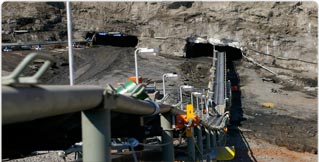After having quadrupled in 2016 and fallen back substantially in the first half of 2017, chrome ore prices have been more stable over the past year, oscillating around $200/t during H1 2018 with a slight upward trend. The average ore production costs have increased largely due to rising oil prices, shipping tariffs and a strengthening South African Rand, which is guiding the upward trend in South African ore prices. Oversupply, encouraged by the very high prices in early 2017, appears to now be preventing chrome ore prices from rising steadily in line with production costs, to the extent that the highest-cost ore production now appears to be close to unprofitable at current price levels.
Ferrochrome prices have largely tracked the development of ore prices over the past two years, given that ore is the largest cost component for ferrochrome, and producers in the largest ferrochrome-producing country (China) have virtually no captive supplies of ore.
Six countries accounted for nearly 90% of chrome ore production in 2017: South Africa, Kazakhstan, India, Turkey, Finland and Zimbabwe. South Africa is by far the largest-producing country for chromite, accounting for more than half of the global total. Most of the country’s chromite production takes place in its Bushveld Complex from primary mines or as secondary production from platinum group element (PGE) mines. While primary production in South Africa remains in the upper half of the cost curve, secondary production was originally predicted to take a more significant role. However, Roskill expects secondary supply to reach a production ceiling over the next five years, with changes in PGE exploration targets and stagnated growth for PGE demand limiting secondary chromite production.
The vast majority of chromite is used in the production of ferrochrome and China has been the world’s largest ferrochrome producer since 2012. In 2017, China accounted for just under 40% of global ferrochrome output. China is likely to remain the largest producing country, although the structure of its ferrochrome supply base is changing, with new large-scale capacity now being commissioned on-site at stainless steel plants, a trend also being developed in Indonesia.
With growing imports of chrome ores into China for use in ferrochrome plants or integrated stainless steel plants, demand for ores and concentrates is expected to grow. Zimbabwe may be poised to become a growing primary chromite supplier in light of growing international investments following the country’s recent political changes. The country has already rapidly increased exports of chrome ore, which rose 65% in Q1 2018 from the previous quarter – nearly 90% of the exports went to China.
Chromium is used predominantly in the production of stainless steel, which is expected to breach the 50 Mt/y production mark in 2018. China now produces over 50% of the world’s stainless steel, and the country will almost certainly remain the largest consumer by far of both chrome ore and ferrochrome over the coming decade.
However, having grown at double-digit percentages for some years, China’s production of stainless steel has begun to stabilise somewhat. In part, this reflects the commissioning by Chinese companies of new large-scale stainless steel capacity in Indonesia. Chinese demand for stainless steel is expected to continue to grow quite strongly over the next decade, translating into continued robust demand growth for chromium on a global level.
Roskill’s new 14th edition of the Chromium Global Industry, Markets & Outlook provides detailed historical analysis and 10-year forecast of chromium production, trade, prices and brand new detailed consumption figures. The report contains detailed analysis of production by company and country and in-depth examination of chromite and ferrochrome consumption across all end-uses including steel alloys, chromium chemicals, foundry applications and refractory applications.











